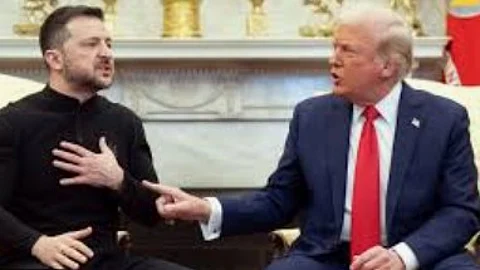

The high drama that followed Ukraine President Volodymyr Zelensky’s meeting with US President Donald Trump has opened up a rift in the international coalition in the Russia-Ukraine war that may change global dynamics in unforeseen ways.
The scene that unfolded in Washington on Friday, when Zelensky was publicly berated by Trump and Senator JD Vance, was an extraordinary and unprecedented diplomatic moment. Trump’s national security adviser, Mike Waltz, even compared Zelensky to a “scorned ex-girlfriend”, and the meeting left many observers in shock. The US, once the leader of the international effort to aid Ukraine, has become more isolationist under Trump – some would even say it is kowtowing to Putin. The sense of betrayal is palpable among many in Europe, who view the US as a key partner in the defence of Ukraine’s sovereignty and territorial integrity.
In contrast, Zelensky found a far warmer reception in London. British Prime Minister Keir Starmer’s embrace of Zelensky, coupled with an audience with King Charles III, symbolized Europe’s continued commitment to Ukraine’s cause. The weekend summit in London, which brought together European leaders, reflected a sense of solidarity and resolve. Starmer called for a “coalition of the willing” to continue supporting Ukraine, with European nations pledging to send troops and bolstering their military aid. It was a sharp contrast to the hostile environment in Washington, underscoring the deepening rift between the US and its European allies over the future of Ukraine.
The British summit was not only a demonstration of support but also a practical step forward in shaping a European-led peace process. Starmer outlined a four-point plan that included a commitment to continued military aid, Ukraine’s involvement in peace talks, and a focus on strengthening Ukraine’s defences to deter future Russian aggression. While the idea of sending troops to Ukraine remains contentious, particularly with countries like Poland and Italy hesitant about direct military intervention, the underlying message was clear: Europe is ready to step up where the US appears to be retreating.
Indeed, the contrast between Washington and London reflects a much larger shift in the global order. Trump’s confrontation with Zelensky and his dismissive attitude toward Ukrainian needs align with his broader “America First” foreign policy approach, which has increasingly isolated the US from its traditional allies. At the same time, European leaders like Macron and Starmer are making a concerted effort to forge a path toward peace without relying on US intervention. Macron even floated the idea of a one-month truce to provide space for negotiations—a proposal that has received mixed reactions but points to Europe’s growing sense of responsibility for Ukraine’s future.
Yet, while European unity on Ukraine is commendable, the reality remains that Europe cannot, at this stage, fully replace the US’s role in the conflict. Despite the calls for a “coalition of the willing”, Europe’s military capacity is limited by years of underinvestment in defence and an over-reliance on NATO and the US for security. As European Commission President Ursula von der Leyen pointed out, Europe must focus on rearming itself, but even that will take time. The immediate challenge for Europe is whether it can sustain its commitment to Ukraine in the face of mounting pressure from Russia and internal divisions over military involvement.
The fallout from Zelensky’s White House meeting has opened a dangerous rift in the Western alliance, one that Moscow is eager to exploit. Kremlin officials have already seized on the discord, with spokesperson Dmitry Peskov criticizing the European-led peace proposals and suggesting that “someone must force Zelensky to change his position.” This rhetoric echoes the Russian propaganda narrative that portrays Zelensky as an obstacle to peace. The Kremlin’s attempts to widen the divide between the US and Europe are part of a broader strategy to weaken the West’s resolve and capitalize on the shifting dynamics in the global order.
The question now is whether the West can find a way to move forward in a united manner. For Zelensky, the path is fraught with challenges. He must balance the pressures from Washington, where some are questioning his leadership, with the growing expectations from Europe to take a more active role in securing peace. At the same time, he must navigate the complex diplomatic terrain between Moscow and the West, knowing that any concessions made at the negotiating table could come at a heavy cost to Ukraine’s sovereignty.
Ultimately, the future of Ukraine and the Western alliance depends on whether Zelensky and his allies can overcome this moment of crisis and forge a path toward peace that preserves Ukraine’s independence and the unity of the free world. The stakes are higher than ever, and the next steps will determine not only the fate of Ukraine but also the future of Western unity in the face of Russian aggression.